brake light Citroen JUMPY RHD 2016 2.G Owner's Manual
[x] Cancel search | Manufacturer: CITROEN, Model Year: 2016, Model line: JUMPY RHD, Model: Citroen JUMPY RHD 2016 2.GPages: 520, PDF Size: 10.54 MB
Page 6 of 520
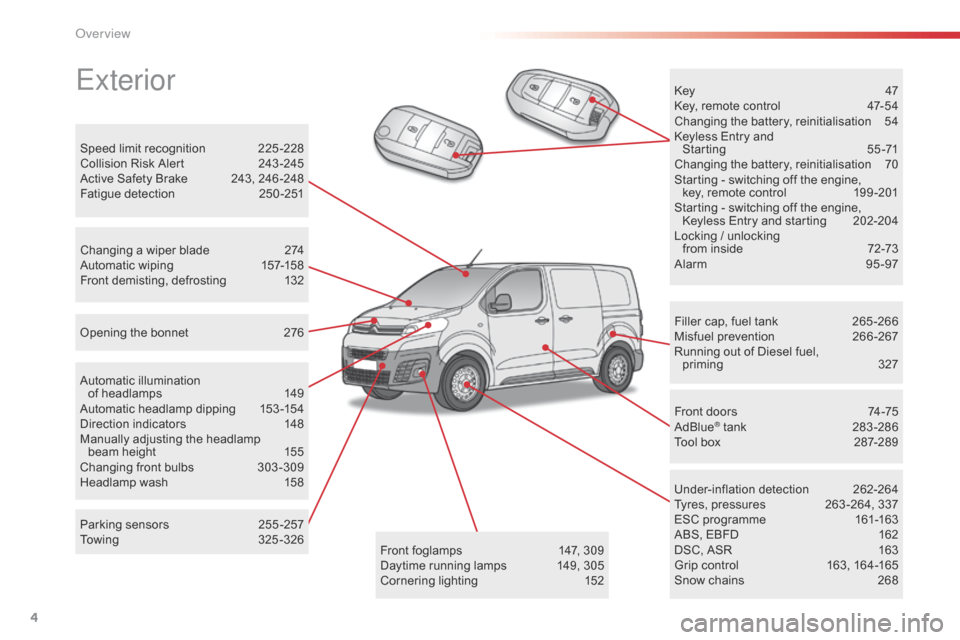
4
Exterior
Filler cap, fuel tank 265 -266
Misfuel prevention 26 6-267
Running out of Diesel fuel, priming
3
27
Under-inflation detection
26
2-264
Tyres, pressures
2
63 -264, 337
ESC programme
1
61-163
ABS, EBFD
1
62
DSC, ASR
1
63
Grip control
1
63, 164-165
Snow chains
2
68
Front doors
7
4-75
AdBlue
® tank 28 3-286
Tool box 2 87-289
Automatic illumination
of headlamps
1
49
Automatic headlamp dipping
1
53 -154
Direction indicators
1
48
Manually adjusting the headlamp
beam height
1
55
Changing front bulbs
3
03 -309
Headlamp wash
1
58
Opening the bonnet
2
76 Key
47
K
ey, remote control
4
7-54
Changing the battery, reinitialisation
5
4
Keyless Entry and Starting
5
5-71
Changing the battery, reinitialisation
7
0
Starting - switching off the engine, key, remote control
1
99 -201
Starting - switching off the engine, Keyless Entry and starting
2
02-204
Locking / unlocking from inside
7
2-73
Alarm
9
5-97
Speed limit recognition
2
25 -228
Collision Risk Alert
2
43 -245
Active Safety Brake
2
43, 246 -248
Fatigue detection
2
50-251
Changing a wiper blade
2
74
Automatic wiping
1
57-158
Front demisting, defrosting
1
32
Front foglamps
1
47, 309
Daytime running lamps
1
49, 305
Cornering lighting
1
52
Parking sensors
2
55 -257
Towing
325
-326
Over view
Page 9 of 520
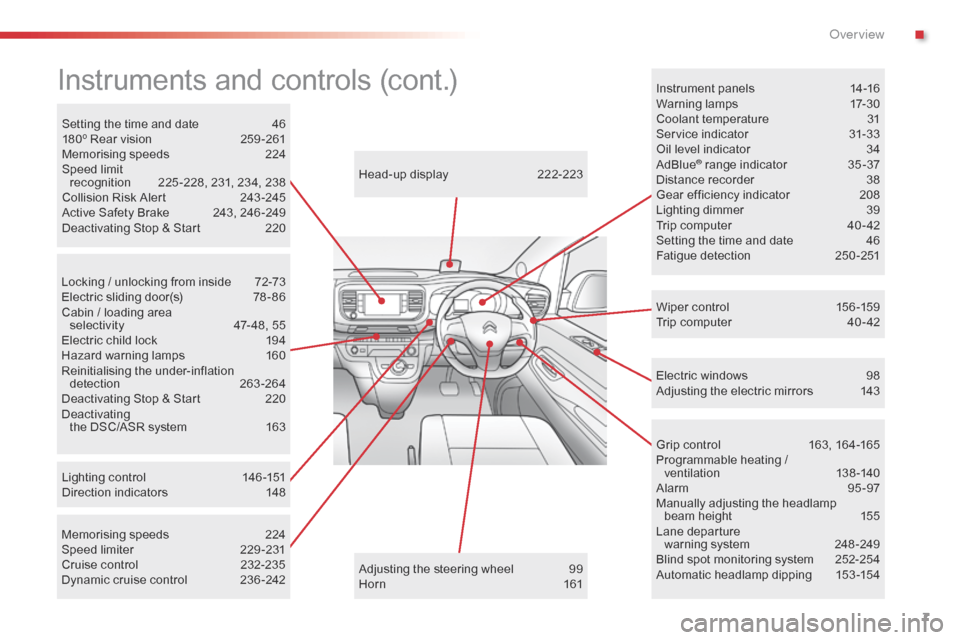
7
Locking / unlocking from inside 72-73
Electric sliding door(s) 7 8 - 86
Cabin / loading area selectivity
4
7- 48, 55
Electric child lock
1
94
Hazard warning lamps
1
60
Reinitialising the under-inflation detection
26
3-264
Deactivating Stop & Start
2
20
Deactivating
the DSC/ASR system
1
63Adjusting the steering wheel
9
9
Horn
16
1
Head-up display
2
22-223
Instruments and controls (cont.)
Wiper control 1
56 -159
Trip computer 4 0 - 42
Memorising speeds
2
24
Speed limiter
2
29-231
Cruise control
2
32-235
Dynamic cruise control
2
36 -242 Instrument panels
1
4-16
Warning lamps
1
7-30
Coolant temperature
3
1
Service indicator
3
1-33
Oil level indicator
3
4
AdBlue
® range indicator 3 5 -37
Distance recorder 3 8
Gear efficiency indicator
2
08
Lighting dimmer
3
9
Trip computer
4
0 - 42
Setting the time and date
4
6
Fatigue detection
2
50-251
Electric windows
9
8
Adjusting the electric mirrors
1
43
Grip control
1
63, 164-165
Programmable heating / ventilation
1
38-140
Alarm
9
5-97
Manually adjusting the headlamp
beam height
1
55
Lane departure
warning system
24
8 -249
Blind spot monitoring system
2
52-254
Automatic headlamp dipping
1
53 -154
Setting the time and date
4
6
180º Rear vision
2
59 -261
Memorising speeds
2
24
Speed limit recognition
2
25 -228, 231, 234, 238
Collision Risk Alert
2
43 -245
Active Safety Brake
2
43, 246 -249
Deactivating Stop & Start
2
20
Lighting control
1
46 -151
Direction indicators
1
48
.
Over view
Page 14 of 520

12
Eco-driving is a range of everyday practices
that allow the motorist to optimise their fuel
consumption and CO
2 emissions.
Eco-driving
Optimise the use of your
gearbox
With a manual gearbox, move off gently and
change up without waiting. During acceleration
change up early.
With an automatic or electronic gearbox,
give preference to automatic mode and avoid
pressing the accelerator pedal heavily or
suddenly.
The gear efficiency indicator invites you to
engage the most suitable gear: as soon as the
indication is displayed in the instrument panel,
follow it straight away.
For vehicles fitted with an electronic or
automatic gearbox, this indicator appears only
in manual mode.
Drive smoothly
Maintain a safe distance between vehicles, use
engine braking rather than the brake pedal,
and press the accelerator progressively. These
practices contribute towards a reduction in fuel
consumption and CO
2 emissions and also help
to reduce the background traffic noise.
If your vehicle has cruise control, make use of
the system at speeds above 25 mph (40 km/h)
when the traffic is flowing well.
Control the use of your
electrical equipment
Switch off the demisting and defrosting controls,
if not automatic.
Switch off the heated seat as soon as possible.
Switch off the headlamps and front foglamps
when the level of light does not require
their
u
se.
Avoid running the engine before moving off,
particularly in winter; your vehicle will warm up
much faster while driving.
As a passenger, if you avoid connecting
your multimedia devices (film, music, video
game...), you will contribute towards limiting the
consumption of electrical energy, and so of fuel.
Disconnect your portable devices before
leaving the vehicle.
Before moving off, if the passenger compartment is
too warm, ventilate it by opening the windows and
air vents before using the air conditioning.
Above 30 mph (50 km/h), close the windows and
leave the air vents open.
Remember to make use of equipment that can
help keep the temperature in the passenger
compartment down (sunroof and window blinds...).
Switch off the air conditioning, unless it has
automatic regulation, as soon as the desired
temperature is attained.
Eco-driving
Page 164 of 520

162
Anti-lock braking system
(ABS) and electronic brake
force distribution (EBFD)
In emergency braking, press ver y
firmly and maintain this pressure. When changing wheels (tyres and
rims), ensure that these are approved
for your vehicle.
Normal operation of the ABS may make
itself felt by slight vibrations of the brake
pedal.
The fixed illumination of this warning
lamp indicates that there is a fault
with the ABS.
The vehicle retains conventional
braking. Drive carefully at moderate
speed.
When this warning lamp comes on,
coupled with the STOP and ABS
warning lamps, accompanied by
an audible signal and a message,
it indicates that there is a fault
with the electronic brake force
distribution (EBFD).
You must stop as soon as it is
safe to do so.
In both cases, have the system
checked by a CITROËN dealer or
a qualified workshop as soon as
possible.
Intelligent traction
control
If fitted to your vehicle, it has a system to help
driving on snow: intelligent traction control .
This system detects situations of difficult
sur face adhesion that could make it difficult to
move off or make progress on deep fresh snow
or compacted snow.
In these situations, intelligent traction
control limits the amount of wheel slip to
provide the best traction and trajectory control
for your vehicle.
The use of snow tyres is strongly
recommended on sur faces offering low
levels of grip.
Safety
Page 198 of 520
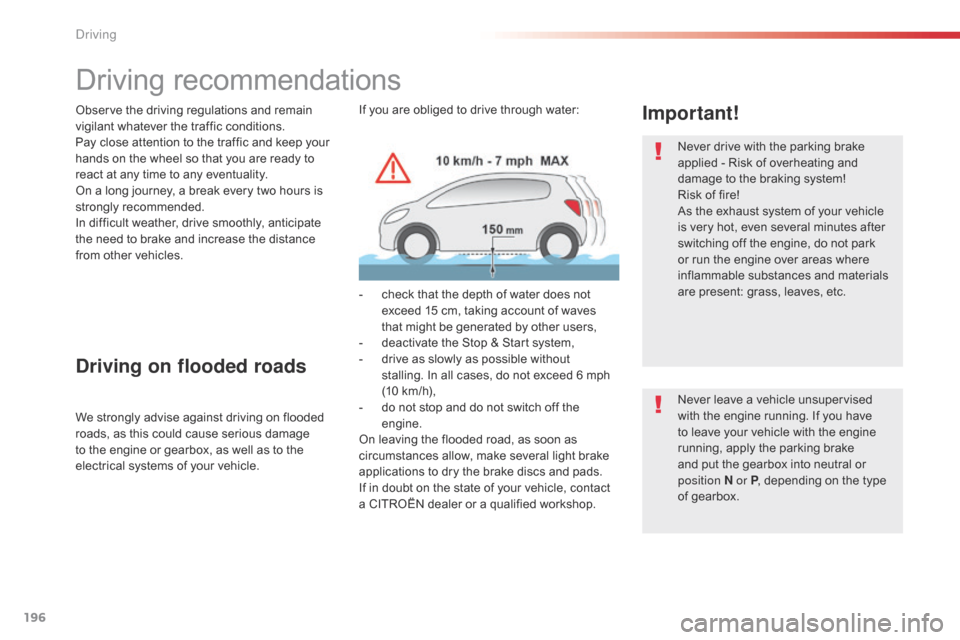
196
Driving recommendations
Observe the driving regulations and remain
vigilant whatever the traffic conditions.
Pay close attention to the traffic and keep your
hands on the wheel so that you are ready to
react at any time to any eventuality.
On a long journey, a break every two hours is
strongly recommended.
In difficult weather, drive smoothly, anticipate
the need to brake and increase the distance
from other vehicles.Never drive with the parking brake
applied - Risk of overheating and
damage to the braking system!
Risk of fire!
As the exhaust system of your vehicle
is very hot, even several minutes after
switching off the engine, do not park
or run the engine over areas where
inflammable substances and materials
are present: grass, leaves, etc.
Never leave a vehicle unsupervised
with the engine running. If you have
to leave your vehicle with the engine
running, apply the parking brake
and put the gearbox into neutral or
position
N or P, depending on the type
of gearbox.
Driving on flooded roads
We strongly advise against driving on flooded
roads, as this could cause serious damage
to the engine or gearbox, as well as to the
electrical systems of your vehicle.
Important!If you are obliged to drive through water:
-
c
heck that the depth of water does not
exceed 15 cm, taking account of waves
that might be generated by other users,
-
d
eactivate the Stop & Start system,
-
d
rive as slowly as possible without
stalling. In all cases, do not exceed 6 mph
(10
km/h),
-
d
o not stop and do not switch off the
engine.
On leaving the flooded road, as soon as
circumstances allow, make several light brake
applications to dry the brake discs and pads.
If in doubt on the state of your vehicle, contact
a CITROËN dealer or a qualified workshop.
Driving
Page 199 of 520
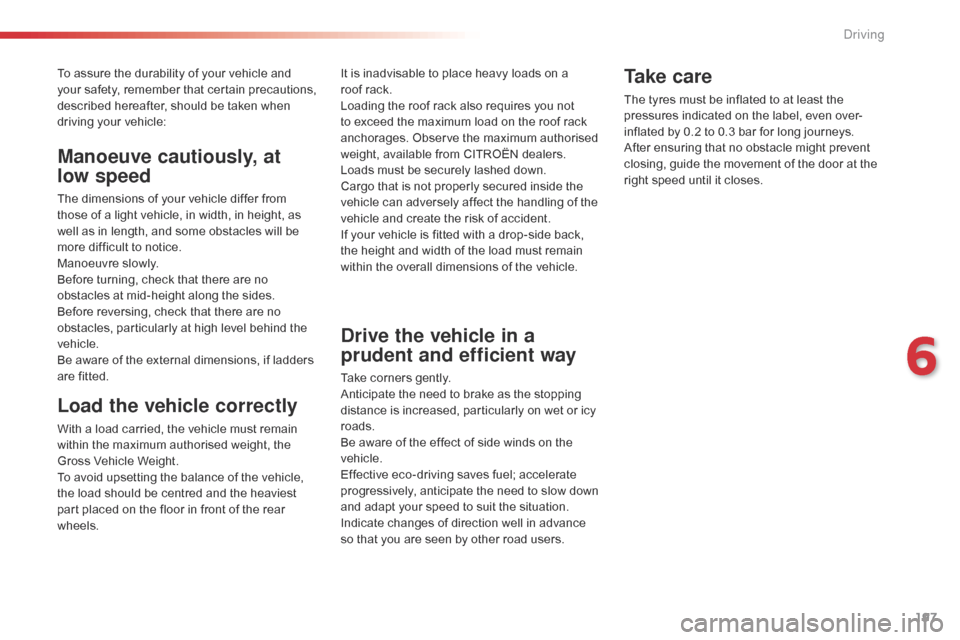
197
To assure the durability of your vehicle and
your safety, remember that certain precautions,
described hereafter, should be taken when
driving your vehicle:
Load the vehicle correctly
With a load carried, the vehicle must remain
within the maximum authorised weight, the
Gross Vehicle Weight.
To avoid upsetting the balance of the vehicle,
the load should be centred and the heaviest
part placed on the floor in front of the rear
wheels.
Manoeuve cautiously, at
low speed
The dimensions of your vehicle differ from
those of a light vehicle, in width, in height, as
well as in length, and some obstacles will be
more difficult to notice.
Manoeuvre slowly.
Before turning, check that there are no
obstacles at mid-height along the sides.
Before reversing, check that there are no
obstacles, particularly at high level behind the
vehicle.
Be aware of the external dimensions, if ladders
are fitted.It is inadvisable to place heavy loads on a
roof
rack.
Loading the roof rack also requires you not
to exceed the maximum load on the roof rack
anchorages. Observe the maximum authorised
weight, available from CITROËN dealers.
Loads must be securely lashed down.
Cargo that is not properly secured inside the
vehicle can adversely affect the handling of the
vehicle and create the risk of accident.
If your vehicle is fitted with a drop-side back,
the height and width of the load must remain
within the overall dimensions of the vehicle.
Drive the vehicle in a
prudent and efficient way
Take corners gently.
Anticipate the need to brake as the stopping
distance is increased, particularly on wet or icy
roads.
Be aware of the effect of side winds on the
vehicle.
Effective eco-driving saves fuel; accelerate
progressively, anticipate the need to slow down
and adapt your speed to suit the situation.
Indicate changes of direction well in advance
so that you are seen by other road users.
Take care
The tyres must be inflated to at least the
pressures indicated on the label, even over-
inflated by 0.2 to 0.3 bar for long journeys.
After ensuring that no obstacle might prevent
closing, guide the movement of the door at the
right speed until it closes.
6
Driving
Page 200 of 520
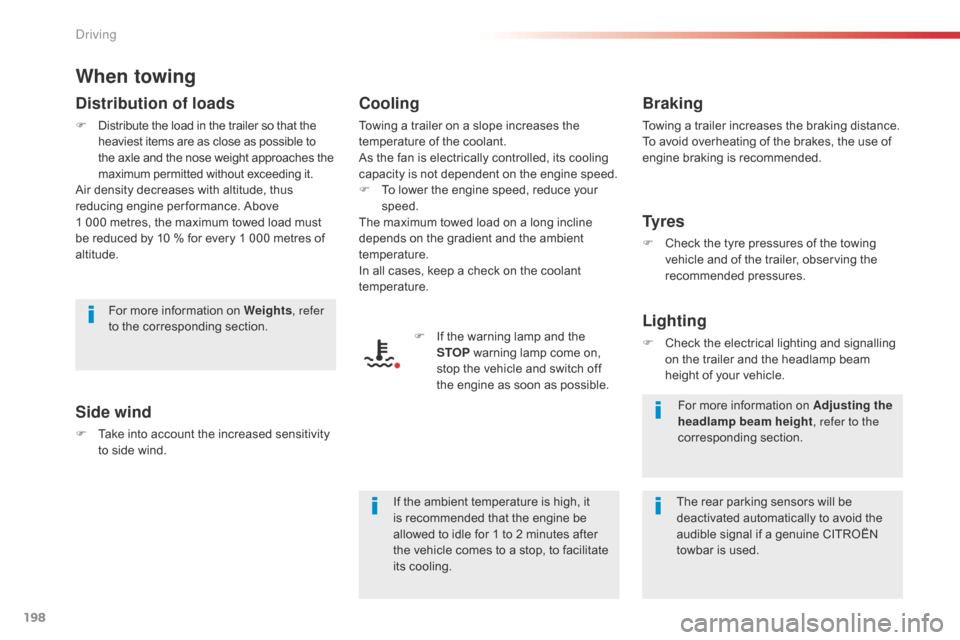
198
When towing
Distribution of loads
F Distribute the load in the trailer so that the heaviest items are as close as possible to
the axle and the nose weight approaches the
maximum permitted without exceeding it.
Air density decreases with altitude, thus
reducing engine per formance. Above
1
000 metres, the maximum towed load must
be reduced by 10
% for every 1 000 metres of
altitude.
Side wind
F Take into account the increased sensitivity to side wind.
Cooling
Towing a trailer on a slope increases the
temperature of the coolant.
As the fan is electrically controlled, its cooling
capacity is not dependent on the engine speed.
F
T
o lower the engine speed, reduce your
speed.
The maximum towed load on a long incline
depends on the gradient and the ambient
temperature.
In all cases, keep a check on the coolant
temperature.
F
I
f the warning lamp and the
STOP warning lamp come on,
stop the vehicle and switch off
the engine as soon as possible.
Braking
Towing a trailer increases the braking distance.
To avoid overheating of the brakes, the use of
engine braking is recommended.
Ty r e s
F Check the tyre pressures of the towing vehicle and of the trailer, observing the
recommended pressures.
Lighting
F Check the electrical lighting and signalling on the trailer and the headlamp beam
height of your vehicle.
For more information on Weights
, refer
to the corresponding section.
The rear parking sensors will be
deactivated automatically to avoid the
audible signal if a genuine CITROËN
towbar is used.
If the ambient temperature is high, it
is recommended that the engine be
allowed to idle for 1 to 2 minutes after
the vehicle comes to a stop, to facilitate
its cooling. For more information on Adjusting the
headlamp beam height
, refer to the
corresponding section.
Driving
Page 220 of 520

218
Stop & StartGoing into engine
STOP mode
If your vehicle has a manual gearbox, its
speed must be below 12 mph (20 km/h) or
stationary (depending on engine); the "ECO"
indicator lamp comes on in the instrument
panel and the engine goes into standby
automatically when you place the gear lever in
neutral and you release the clutch pedal.
For your comfort, during parking
manoeuvres, STOP mode is not
available for a few seconds after
coming out of reverse gear.
Stop & Start does not affect the
functionality of the vehicle, such as for
example, braking, power steering...
A slight delay between the vehicle
stopping and the engine cutting out may
be noticed.If your vehicle is fitted with
Stop & Start, a time counter
calculates the time spent in
STOP mode during a journey.
It resets to zero every time the ignition is
switched on.
Stop & Start time counter
The Stop & Start system puts the engine
t emporarily into standby - STOP mode - during
stops in the traffic (red lights, traffic jams, or
other...). The engine restarts automatically -
START mode - as soon as you want to move
off. The restart takes place instantly, quickly
and silently.
Per fect for urban use, the Stop & Start system
reduces fuel consumption and exhaust
emissions as well as the noise level when
stationary.
If your vehicle has an automatic gearbox
and the vehicle is stationary, the "ECO"
indicator lamp comes on and the engine goes
into standby automatically when you press
the brake pedal or place the gear selector in
position N .
If your vehicle has an electronic gearbox and
the vehicle's speed is below 5 mph (8 km/h),
the "ECO" indicator lamp comes on and the
engine goes into standby automatically when
you press the brake pedal or place the gear
selector in position N . (minutes / seconds or hours / minutes)
Never refuel with the engine in
STOP
mode; you must switch off the
ignition with the button.
Driving
Page 248 of 520

246
This system, also called automatic emergency
braking, aims to reduce the speed of impact
or avoid a frontal collision by your vehicle
(between 3 and 87 mph (5 and 140 km/h))
where the driver fails to react.
Using a radar and a camera, this system acts
on the vehicle's braking system.
Active Safety Brake
The driver can take back control of the vehicle
at any time by sharply turning the steering
wheel and/or pressing the accelerator pedal.Operation of the system may be felt by
slight vibration in the brake pedal.
If the vehicle comes to a complete stop,
the automatic braking is maintained
for
1 to 2 seconds.
If your vehicle has a manual gearbox, in
the event of the automatic emergency
braking bringing the vehicle to a
complete stop, the engine may stall.
If your vehicle has an automatic
gearbox, in the event of the automatic
emergency braking bringing the vehicle
to a complete stop, the vehicle will
move off again; press the brake pedal.
If automatic emergency braking is
not activated, you are alerted by the
fixed display of this warning lamp
accompanied by a message.
If the radar and the camera have
confirmed the presence of a vehicle
or a pedestrian, this warning lamp
flashes when the system is operating.
Important
: if operation of the
automatic emergency braking is
triggered, you should take back
control of your vehicle and brake
with the pedal to add to or finish the
automatic braking.
The point at which braking is triggered
may be adjusted according to the
reaction from the driver, such as
movement of the steering wheel or
pressing the accelerator pedal.
Driving
Page 249 of 520

247
Deactivation / Activation of
the alert and the braking
By default, the function is automatically
activated at every engine start.
The deactivation or activation of the function is
done in the vehicle configuration menu.
With the audio system
In the "Personalisation-configuration "
menu, activate/deactivate " Auto. emergency
braking ".
Intelligent emergency
braking assistance
If the driver does not brake sufficiently
to avoid an accident, this system will
complete the braking.
This emergency braking system will not
act if you press the brake pedal.
With the touch screen
In the vehicle settings menu, activate/
deactivate " Collision risk alert and automatic
braking ". In the event of a fault, you are alerted
by the illumination of this warning
lamp, accompanied by an audible
signal and a message.
Contact a CITROËN dealer or a
qualified workshop.
Operating fault
There may be inter ference in the
operation of the camera or it not work at
all in the following situations:
-
p
oor visibility (inadequate street
lighting, falling snow or rain, fog, ...),
-
d
azzle (headlamps of an
approaching vehicle on the other
side of the road, low sun, reflection
on a wet road, leaving a tunnel,
alternating between light and
shade, ...),
-
t
he area in front of the windscreen:
dirty, misty, frosty, snow-covered,
damaged or covered by a sticker.
The operation of the radar, located in
the front bumper, may be disturbed
in certain weather conditions: with
accumulations of snow, ice, mud, ...
6
Driving